
Arbutus: planting, pruning and caring tips
Contents
The Strawberry Tree in a nutshell
- Floriferous and fruit-bearing, with fruits resembling strawberries, it dazzles from autumn to winter
- With its evergreen foliage, flowering, and decorative fruits, it remains beautiful all year round
- It makes a great impact in borders, hedges, and even in pots
- Easy to grow in mild climates and well-drained soil, it is the king of Mediterranean gardens
- Hardy down to -12 to -15°C, it is quite resistant to cold and very drought-resistant
A word from our expert
The Strawberry Tree, Arbutus or “Tree of Strawberries” is a small bush typical of Mediterranean scrubland, cultivated in gardens for its remarkable ornamental qualities from autumn until early winter: decorative and edible round fruits resembling strawberries, which turn from yellow to red as they ripen, alongside a long flowering period of white or pink bell-shaped flowers, a scaly bark, and a beautiful evergreen foliage that remains glossy throughout winter.
Essential and very common in the South of France, this southern bush thrives in a mild climate spared from severe cold. However, climate change is increasingly working in its favour in colder regions!
With moderate growth, it is perfect for creating beautiful free hedges or as a solitary specimen to compose exotic scenes in dry, low-maintenance gardens, in small gardens, and even on a sunny terrace.
Hardy down to -12 to -15°C when protected from prevailing winds, undemanding, disease-resistant as well as drought-tolerant, the Strawberry Tree is easy to grow in a warm sunny position or in partial shade. It prefers rather acidic soil, not too calcareous but especially well-drained. By the sea, its foliage withstands salt spray. This low-maintenance bush is only vulnerable to severe frosts.
In overly harsh winter climates, it is advisable to grow it in a pot. Some dwarf varieties of Arbutus, such as Arbutus unedo ‘Compacta’, well-suited for pot cultivation, allow for use in small gardens or on terraces and balconies in the northern half of the country.
While the bark and leaves of the Strawberry Tree have anti-inflammatory and anti-rheumatic properties and are used against hypertension, its fruits with a tangy flesh are used in the preparation of various recipes: jams, liqueurs, jellies, honey…
For planting, pruning, and harvesting, discover our range of Strawberry Trees at all prices, the best varieties, and all our care tips for this original Mediterranean fruit tree.
Botany
Botanical data
- Latin name Arbutus
- Family Ericaceae
- Common name Strawberry tree, Tree of strawberries
- Flowering October to November
- Height 2 to 15 m
- Exposure Sun, partial shade
- Soil type Acidic, well-drained
- Hardiness -12 to -15°C depending on varieties
The Strawberry tree, also known as the “Tree of strawberries”, is a southern bush that belongs to the family Ericaceae, which includes heathers and rhododendrons. It is primarily native to the rocky areas of North America, Mexico, and southern Europe and the Mediterranean. In its natural state, it grows in well-drained soil, generally rather acidic, even stony.
It is a common shrub in the gardens of the southern half of France, from the garrigue to the Corsican maquis and the sandy shores of the Landes and Nantes coasts, where it grows alongside maritime pines, cork oaks, or holm oaks in acidic soils, forming true colonies known as “arbousas.” From its Mediterranean origins, it has retained a great resistance to drought, with its long roots able to descend up to 10 m deep. It can also be found at altitudes of up to 600 m.

The Strawberry tree, a Mediterranean tree by nature, is very common in the maquis
We also distinguish its Greek cousins, Arbutus andrachne and Arbutus x andrachnoides, a hybrid between unedo and andrachne, reaching about ten meters in height. Not to mention the American giant Arbutus menziesii, or California Strawberry tree, which can reach 30 meters in height and whose leaves are much larger than those of its European cousins.
The Strawberry tree is a typical shrub of mild climates, thriving in regions with mild winters and fearing severe frosts. That said, in a sheltered position from cold and dominant winds, it can withstand temperatures close to -15°C for a short period without its foliage suffering. Some, like Arbutus andrachne and Arbutus x andrachnoides, are hardier and can resist down to -20°C. They acclimatise to harsher regions provided they are planted in the sun and sheltered from drafts. It is preferable to grow the Strawberry tree in a pot in regions with too cold winters.
The Arbutus also acclimatises perfectly by the sea. Originally, it was very widespread around the Mediterranean and in the South-West of France, this southern shrub has eventually naturalised as far as Ireland, a testament to its relatively limited hardiness and, if anything, to climate change!
The Strawberry tree is a so-called pyrophilous species; after a fire, it quickly reclaims its rights to recolonise the area, with the passage of fire promoting the germination of dormant seeds.
The Strawberry tree grows quite slowly and forms a bush made up of several twisted trunks. The bushy silhouette is more or less compact depending on the species. In our gardens, the Strawberry tree typically maintains a modest height of 3 to 5 m at maturity, with a similar width.
Its slow growth is matched only by its longevity of centuries: when planted in suitable conditions, it can live for several hundred years.
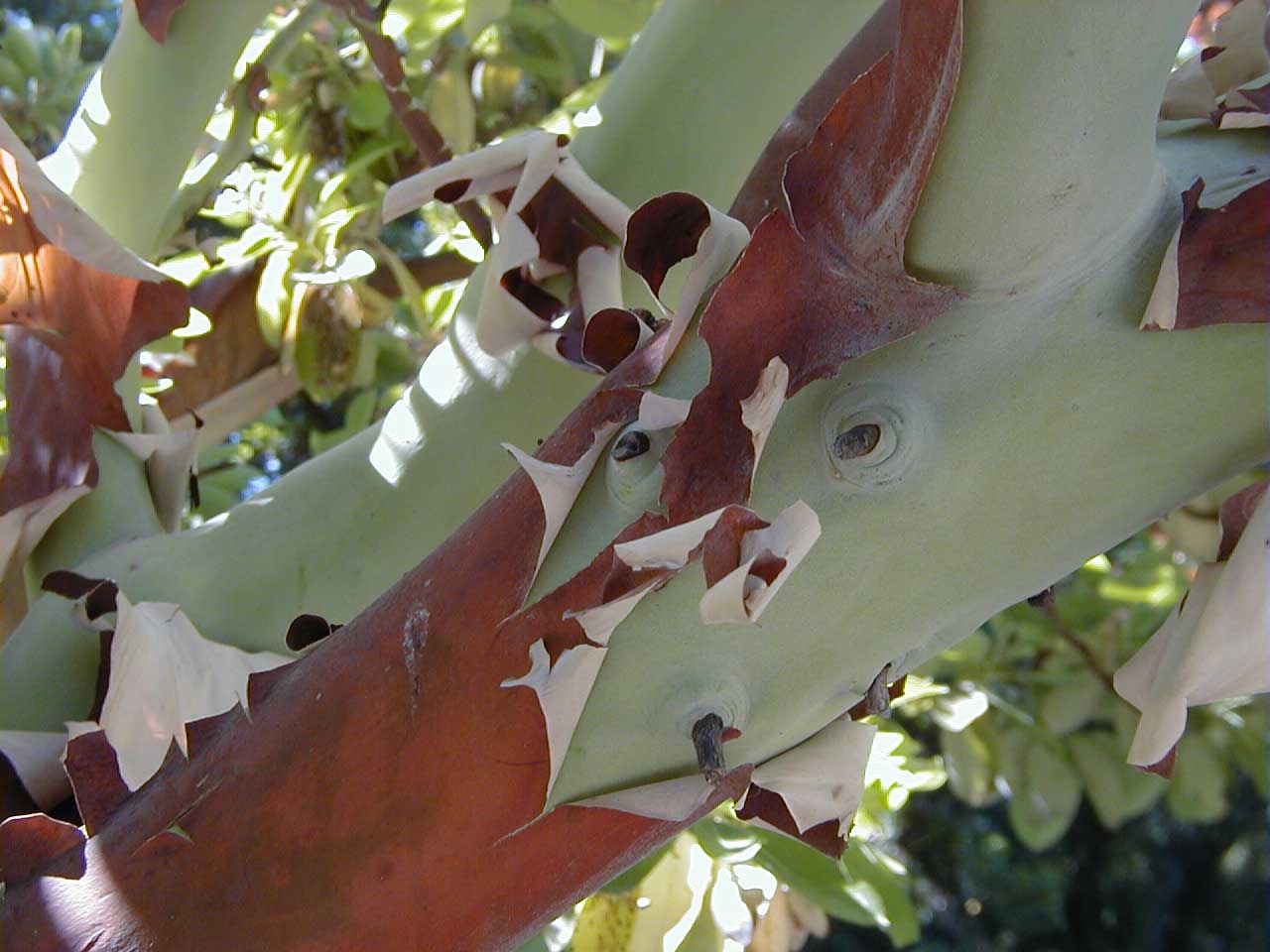
The Arbutus andrachne and its bark that exfoliates, revealing a brand new, smooth and light skin
Most have a beautiful scaly reddish-brown bark that exfoliates in spring in fine strips like that of plane trees, revealing the new cream or green bark underneath. The young, upright shoots and secondary branches display a reddish hue.
The shrub offers a beautiful dark green or medium green foliage that remains evergreen throughout winter. The oval leaves, dark green on the upper side and light green or glaucous underneath, are glossy, simple, leathery, sometimes dentate at the edges or entire. They measure 5 to 15 cm long.
It is on this dense and shiny foliage that clusters of white flowers and fruits appear.
The Arbutus unedo, the most cultivated in our gardens, flowers in autumn, in September-October, at the same time as the berries ripen. Other strawberry trees flower at different times of the year: Arbutus andrachne flowers from March to May, Arbutus menziesii in May.
The white-green or cream-white flowers, or pink in the cultivar ‘Roselily’, bell-shaped and 7 mm in diameter, reminiscent of lily of the valley or small hollowed-out eggshells, are grouped in pendulous clusters ranging from 5 cm to 20 cm long in Arbutus menziesii. Melliferous, they attract many pollinating insects to the garden and offer an abundant and long flowering in autumn and winter, appearing in Arbutus unedo from late August to early September until January.
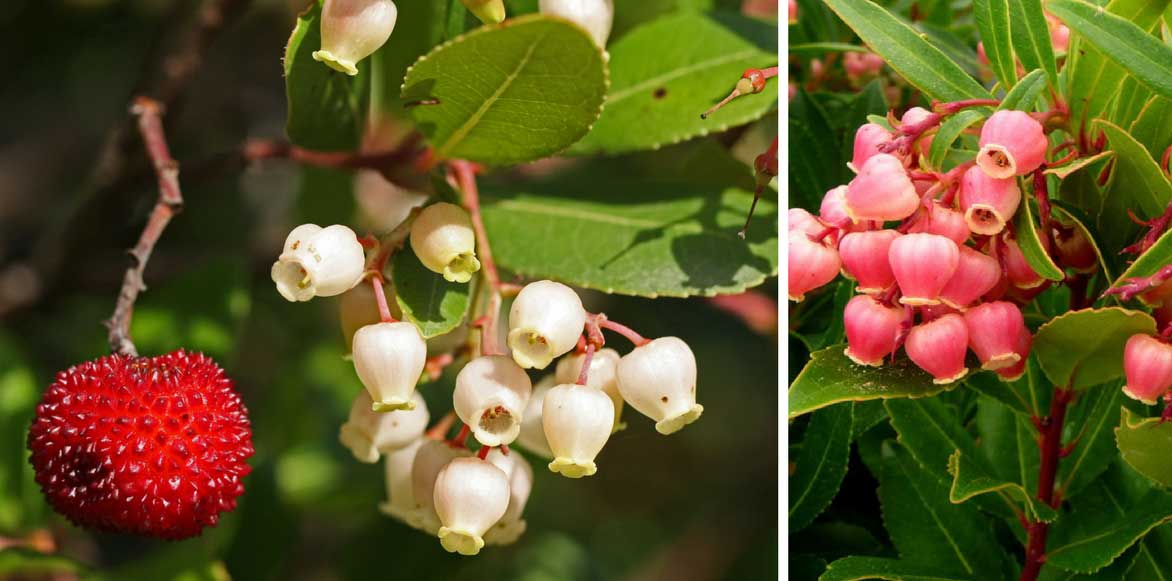
The flowers of the Strawberry tree vary according to the cultivars, white in Arbutus unedo (LD-Miltos Gikas) or pink as in A. unedo ‘Rubra’.
It flowers for a long time, continuously producing a quantity of delicate flowers beautifully highlighted by its glossy dark green and leathery foliage.
This decorative shrub has one of the most interesting fruiting habits. The flowers coexist with the fruits or arbouses, from the previous year finally ripening: it takes a year for the drupes to mature! A year after flowering, they thus give way to small edible round fruits, with a rough skin and covered in small spikes, first green, then yellow, and finally scarlet red when ripe, by the end of October.
Resembling strawberries, these small fleshy balls are highly appreciated by birds who feast on them when their food supply begins to dwindle, measuring 2 to 3 cm in diameter (up to 12 mm in Arbutus andrachne and 1 cm in diameter in Arbutus menziesii). These very decorative red fruits persist on the shrub throughout winter.
In the heart of winter, the Strawberry tree retains both its foliage and simultaneously bears the white or pink flowers of the year, as well as the magnificent ripe vermilion fruits from the previous season.
Fruiting is more or less slow depending on the species and varieties: it will take more than 5 years for Arbutus unedo to bear fruit after sowing, while others like Arbutus unedo ‘Compacta’ are fruitful from the first years.
The flesh, rich in vitamin C, white and containing many small black seeds, is floury, tangy, and sweet. While they can be eaten raw in moderation, the arbouses, which are harvested when fully ripe and slightly softened, are best consumed cooked in compotes, jellies, jams, or even fermented for the production of brandy or arbouse liqueur.
→ to read on the subject: “The Arbouse: an edible fruit to discover
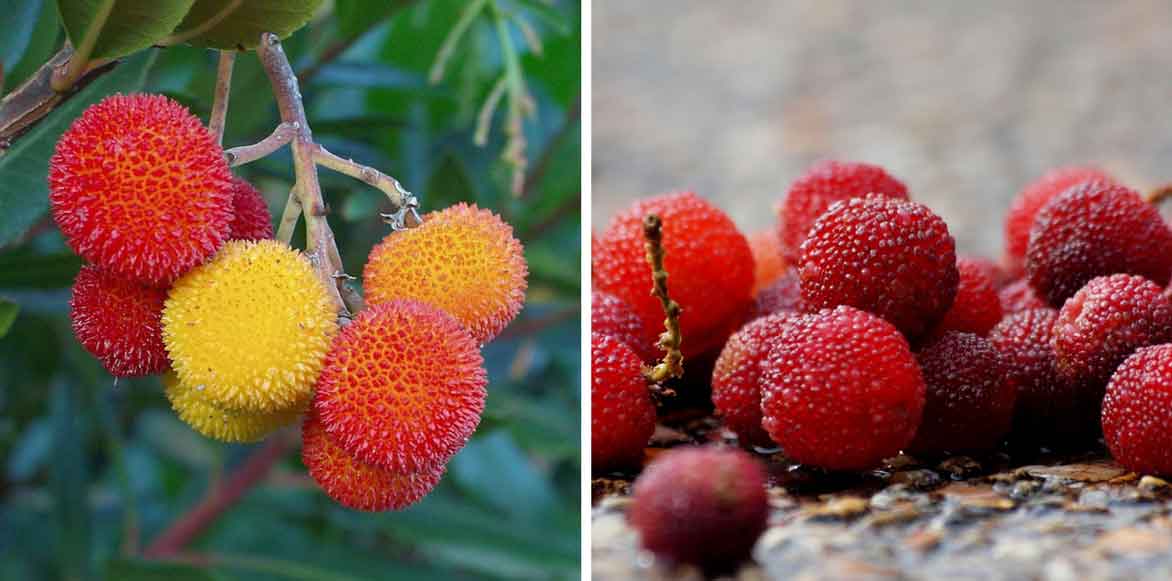 Not very tasty, the flesh of the arbouses is rather bland and slightly sour: unedo means that one only eats one, to say the least!
Not very tasty, the flesh of the arbouses is rather bland and slightly sour: unedo means that one only eats one, to say the least!
Easy to cultivate, the Arbutus, Mediterranean by nature, fears neither long, hot, and dry summers, which help it ripen its fruits, nor poor and stony soils. It is undemanding and requires little if planted in rather acidic, light, well-draining soil, even very dry in summer. It can tolerate ordinary soil, even slightly calcareous, provided it is perfectly drained. It enjoys a sunny or partially shaded position but protected from dry and cold winds, sheltered by a wall, especially in windy regions.
However, it does not tolerate overly wet or calcareous soils very well. While it is resistant and not very sensitive to diseases, it can still be subject to “Strawberry tree Septoria,” which affects its leaves, without being fatal.
The Strawberry tree is a very decorative shrub that reveals its true splendour in autumn when other plants enter their resting period. It is resplendent and creates exotic scenes in mild climates on the terrace or in a dry, low-maintenance garden.
With its decorative red berries and lush foliage remaining green all year round, it is a must-have on the Mediterranean coast or in a moderately to warm Atlantic climate, planted in a sheltered location, to form a free hedge or dress a wall, in groups associated with other shrubs like Buddleias, Ceanothus, autumn Camellias, Abelia, and Berberis.
It will be an unusual subject planted in isolation or as a focal point in a bed accompanied by perennials; large wormwoods, shrubby sages, sedum, heleniums.
It pairs perfectly with dwarf pomegranates, Leikora sea buckthorn, or the bright red fruits of a Nepalese plum or Cotoneaster horizontalis. It will harmonise beautifully with a Mexican orange, a blood dogwood, or a spindle tree.
Its very slow growth and the modest dimensions of some varieties allow it to be planted in large pots in regions with less mild winters north of the Loire: it will be a lovely decorative subject all year round with its persistent green and shiny foliage, for example, accompanying a winter heather.
The Strawberry tree is a medicinal plant whose leaves and roots have recognised qualities against hypertension and possess anti-inflammatory and anti-rheumatic properties.
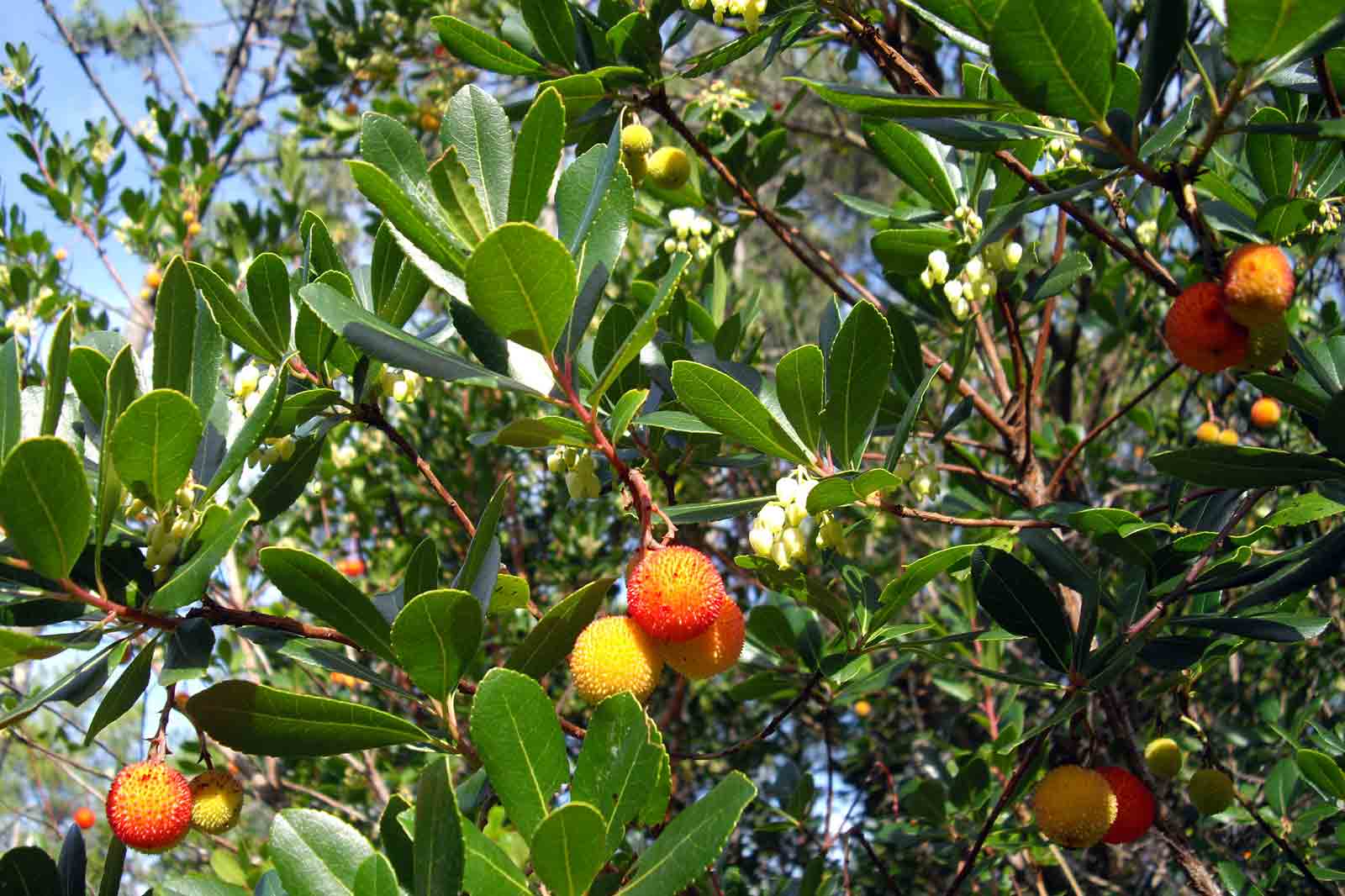 In autumn, Arbutus unedo offers a particularly decorative display: against a backdrop of evergreen foliage, the ripe orange-red fruits often coexist with clusters of flowers.
In autumn, Arbutus unedo offers a particularly decorative display: against a backdrop of evergreen foliage, the ripe orange-red fruits often coexist with clusters of flowers.
Read also
Arbutus: diseases and treatmentsSpecies and varieties
If we count around fifteen species of Arbutus, four of which are very common: the most cultivated in our gardens that experience mild winters and the smallest is Arbutus unedo, which has given rise to some interesting cultivars such as A. unedo ‘Compacta’, a dwarf variety ideal for pot cultivation, the compact ‘Roselily’, and A. unedo ‘Atlantic’, two selections from Minier nurseries perfect for small gardens.
Alongside Arbutus unedo, there are other species of strawberry trees: Arbutus andrachne and Arbutus x andrachnoides, a hybrid between unedo and andrachne, reaching heights of 6 to 8 metres and more resistant to cold, and the gigantic Arbutus menziesii, or California strawberry tree, which can reach 30 metres in height.
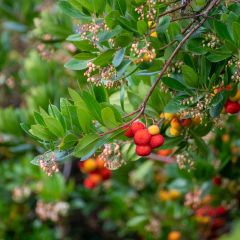
Arbutus unedo - Strawberry tree
- Height at maturity 5 m
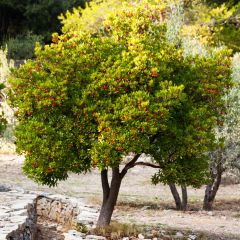
Arbutus unedo Compacta - Strawberry tree
- Height at maturity 2,50 m

Arbutus unedo Atlantic - Strawberry Tree
- Height at maturity 2 m
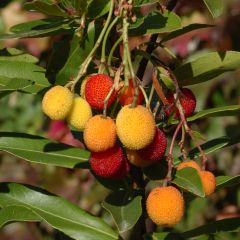
Arbutus unedo Roselily - Strawberry Tree
- Height at maturity 2,50 m
Discover other Arbutus - Strawberry tree
View all →Available in 3 sizes
Available in 1 sizes
Available in 2 sizes
Available in 2 sizes
Available in 1 sizes
Available in 1 sizes
Available in 1 sizes
Available in 1 sizes
Available in 1 sizes
Available in 1 sizes
Planting
Where to plant the Strawberry Tree?
This bush prefers to settle in regions spared from severe cold south of the Loire, in Mediterranean areas and along the Atlantic coast as it fears harsh winters. The Strawberry Tree can survive in all regions where temperatures are unlikely to drop below -15° C to -20° C. However, climate change increasingly works in its favour in less clement lands.
It tolerates sea spray but is wary of winter storms that scorch its evergreen foliage: although hardy, it will appreciate being planted sheltered from cold winds.
The Strawberry Tree is planted in full sun or partial shade in neutral or preferably acidic soil, such as heather soil, provided it is well-drained.
It is a valuable bush in free hedges, at the centre of a shrub or perennial bed in sunny areas, or even in an orchard. Compact varieties are well-suited for growing in large pots on terraces and balconies, especially in regions with harsh winters in the northern half of France, where they will spend the cold season in a conservatory.
With very slow growth, it is a space-saving bush that is well-suited for small gardens or urban gardens.
However, choose its location carefully as once well-established, it does not like to be transplanted.
When to plant the Strawberry Tree?
To encourage its establishment, the Arbutus is preferably planted in the ground in spring, ideally in March, or in autumn, in September. Planting is also possible from February to the end of March and from late summer until November, but outside periods of extreme heat and frost.
How to plant it?
Planting is the crucial step; the Arbutus can manage with ordinary soil but drainage must be perfect.
In the ground:
For hedges, maintain 1 m between each bush.
- Loosen the soil
- Dig a hole 3 to 5 times wider than the root ball and 50 cm deep
- Plant the bush at collar level, in a mixture of loamy soil, heather soil, and an organic fertiliser
- Add pumice if your soil is poorly draining
- Fill the hole
- Lightly compact the soil
- Water regularly during the first year after planting
- Protect it from severe frosts with mulch and a winter cover
Pot culture
North of the Loire, it is preferable to grow it in a pot when the winter climate is too harsh as the Strawberry Tree fears only one thing: severe frosts. The Strawberry Tree is a beautiful specimen in a pot, especially as there are remarkable dwarf varieties like Arbutus unedo ‘Compacta’.
Provide a very draining and light mix based on soil, true heather soil, and well-decomposed compost, as it does not tolerate stagnant moisture. Choose a large container of at least 30 to 40 cm in diameter. Water regularly but sparingly. In winter, in very cold regions, bring the bush indoors to a bright place. Take it out when temperatures begin to warm up.
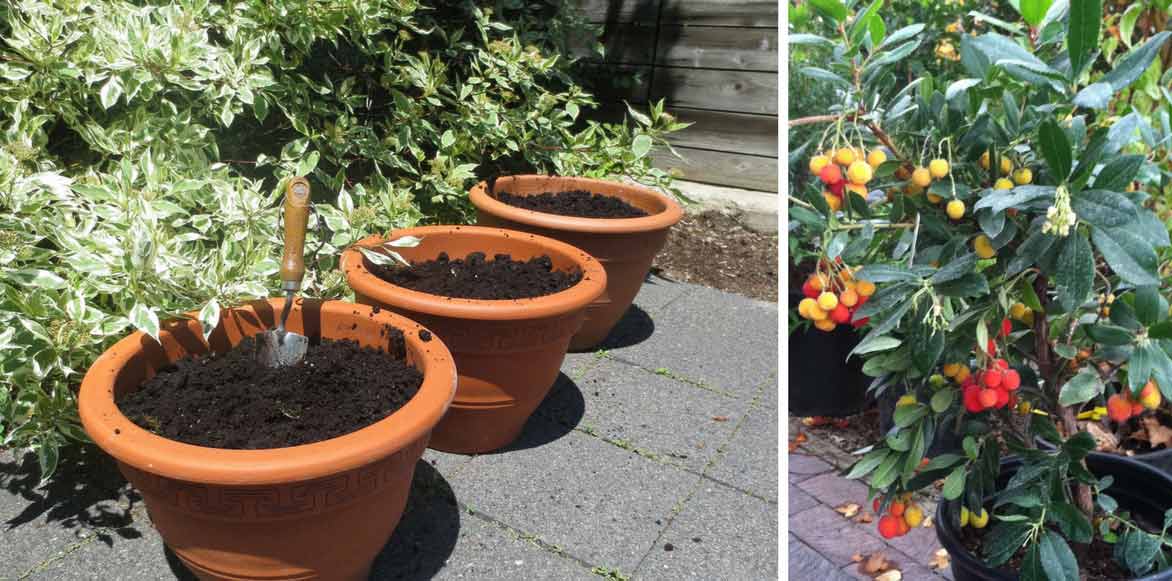 The Arbutus unedo ‘Compacta’, a beautiful dwarf variety perfectly suited for planting in a large pot in the sun[/caption>
The Arbutus unedo ‘Compacta’, a beautiful dwarf variety perfectly suited for planting in a large pot in the sun[/caption>
Read also
Coastal garden designMaintenance, pruning and care
A well-established strawberry tree is remarkably undemanding and requires no fertiliser or special care. Ensure to water well, 2 to 3 times a month, during the first year after planting. Once established, after 2 or 3 years, it will tolerate drought well, dry soils, and will not require watering in summer, even during periods of intense heat, except for potted specimens, which are more sensitive to lack of water.
In autumn, during the first few years, spread a good layer of organic mulch (bark or pine needles, leaf litter), and install a winter cover to protect it from severe frosts. Learn more in our article Protecting and wintering the strawberry tree.
With slow growth, pruning is not necessary. Only intervene in spring to remove any dead branches or to carry out a very light refresh to maintain a balanced habit.
Pests and potential diseases
Cultivated under good conditions, the Strawberry Tree proves to be resistant and not very susceptible to diseases and pests. However, it can quite frequently be subject to attacks from aphids and foliar spots, particularly “Strawberry Tree Septoria”, both of which are not serious.
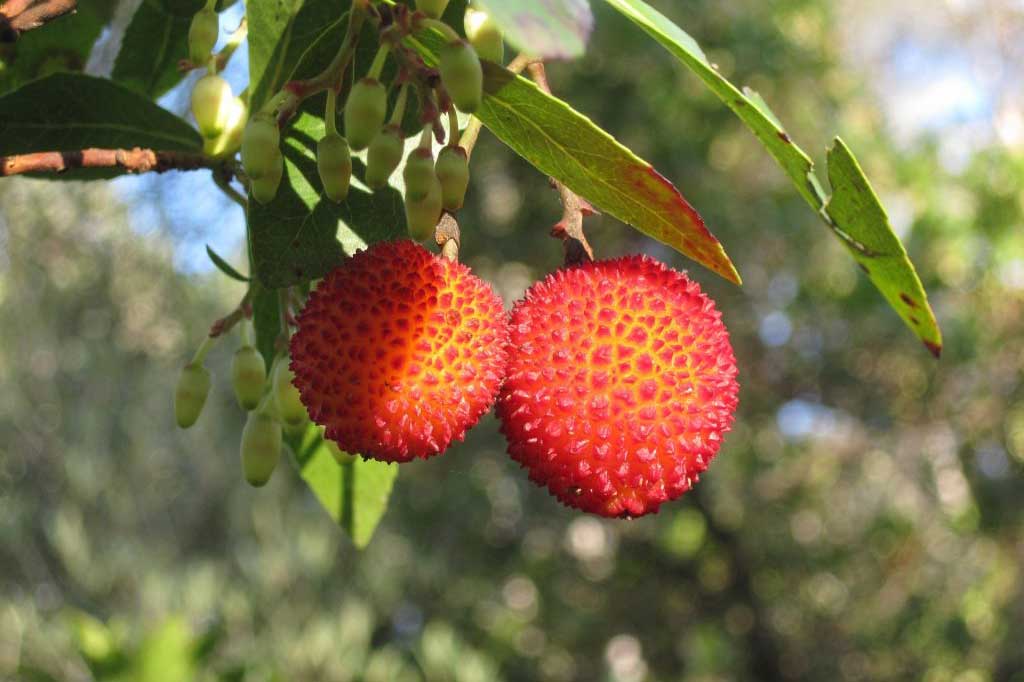
Strawberry Tree Septoria is the most well-known disease of the strawberry tree
Multiplication
If the Strawberry Tree can be multiplied by sowing in pots under a cold frame in autumn and by cutting, layering, although very slow, remains the most suitable method. The root development is very slow, so patience is required; the appearance of roots can take two years.
By layering
- At the end of summer, in August, choose a flexible branch at the base of the tree that is easy to bend
- Dig a furrow in the soil near the mother plant
- Lower the shoot to the ground
- Remove leaves and shoots from this part of the stem
- Scratch the bark with your nail or a small knife over 5-10 cm
- Lay one of the shoots of the Arbutus on the ground, burying part of it to encourage rooting at a depth of 5 cm
- Fill in the furrow and secure the layer with two metal hooks (such as camping pegs)
- Raise the end and stake the aerial part
- One or two years later, you can separate the layer from the mother plant when it has enough roots and replant it in the ground
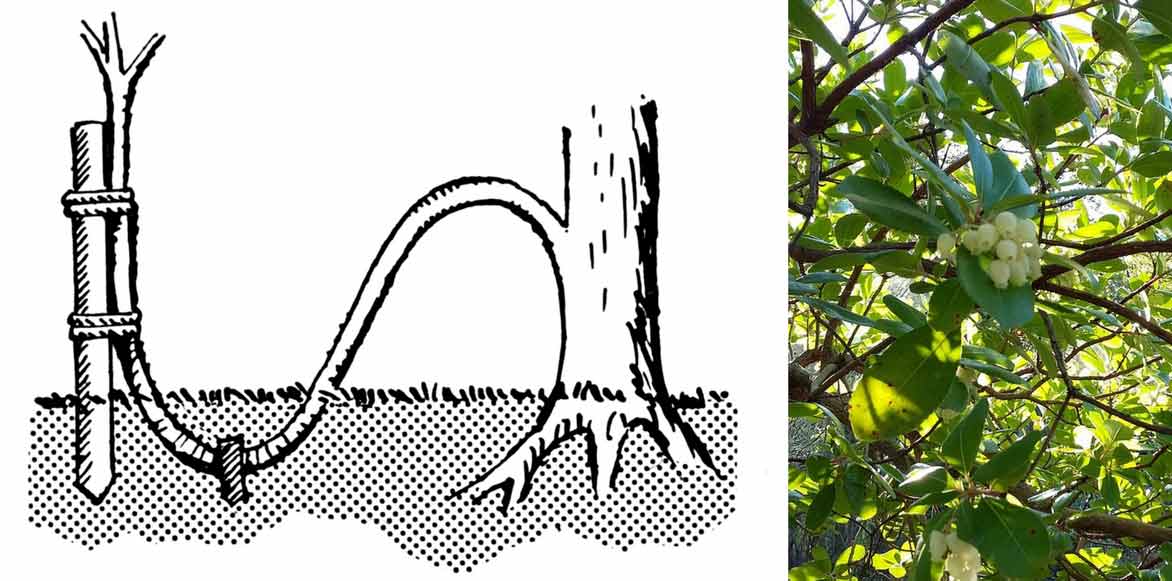
Layering: a simple and effective method to multiply the strawberry tree
Associating
The Strawberry Tree is highly valuable for awakening its bright berries in free and fruiting hedges or in groups of evergreen bushes alongside Buddleias (Buddleia weyeriana ‘Sungold’), Ceanothus or California Lilacs, Autumn Camellias, Common Myrtle, Abelia, and Berberis ( B. thunbergii ‘Orange Rocket’).
It pairs perfectly with dwarf pomegranates Punica granatum ‘Nana’, the orange berries of a Sea Buckthorn, the bright red fruits of Carissa macrocarpa or Cotoneaster horizontalis, and the splendid scarlet brushes of a Callistemon. It will be in perfect harmony with a Pittosporum tobira with its evergreen, thick, glossy green foliage, a Mexican Orange, a Cornus sanguinea, or even a European Spindle ‘Red Cascade’, as well as with hawthorns that will highlight its fruiting during winter.
Its dark foliage creates interesting contrasts with grey-leaved shrubs like wormwoods or that of a Buddleia ‘Silver Anniversary’ or yellow ones (Sambucus nigra ‘Golden Tower’). It will also blend well with autumn colours alongside Cotinus or as a focal point in a group of Mediterranean perennials with late flowering such as shrubby salvias, sedums, heleniums, or California Fuchsia.
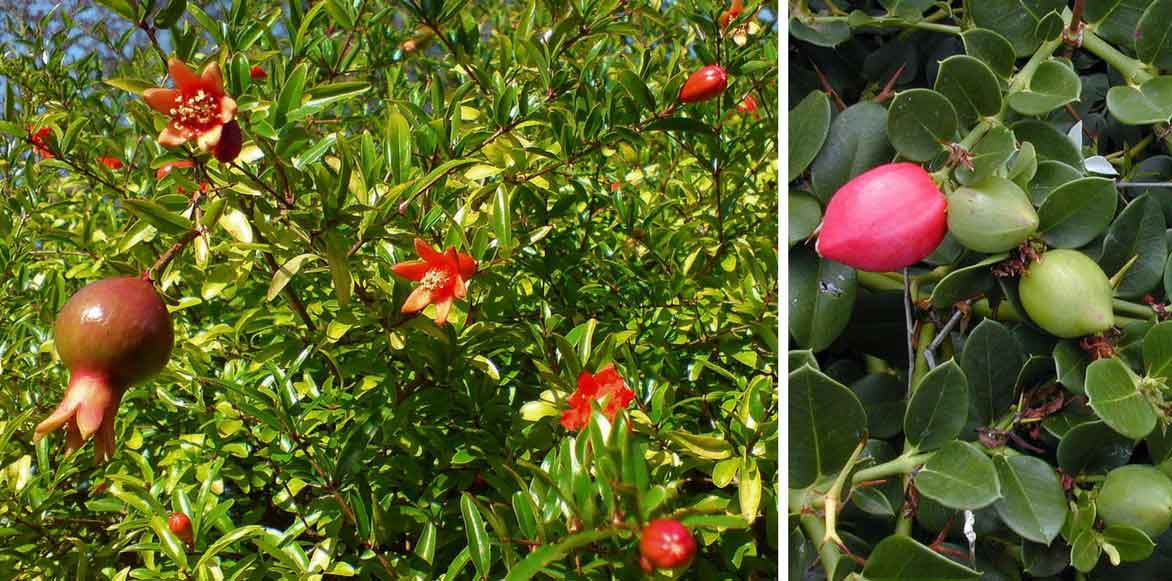
Punica granatum ‘Nana’ and Carissa macrocarpa will be good companions for the Strawberry Tree!
→ Discover more association ideas with the Strawberry Tree in our advice sheet.
Useful resources
- Discover our beautiful range of Strawberry Trees and our article Strawberry Tree: how to choose the ideal variety?
- Follow tips to care for your arbutus: “Strawberry Tree – diseases and treatments“.
- Our tips for growing a Strawberry Tree in a pot
- Strawberry Tree: how to harvest and use its fruits in cooking?
- Discover Sophie’s advice sheet: 7 trees for seaside gardens
- Why is my Strawberry Tree not producing fruits?
Frequently asked questions
-
Why does my strawberry tree have yellow leaves?
To begin with, don't worry too much; it is normal for the oldest leaves to turn yellow even in evergreen bushes. The strawberry tree prefers well-drained, free-draining soils. Yellowing and falling leaves may indicate an excess of water. Be careful not to plant it too deeply in heavy or clayey soil and to water it moderately. The strawberry tree enjoys dry, somewhat stony soils. Furthermore, the cause may also be related to exposure: your strawberry tree needs strong sunlight and does not like draughts, so ensure that its location is suitable.
-
My Strawberry Tree is losing its leaves in a worrying manner, and they are also marked with brown spots. What should I do?
The Strawberry Tree is very resilient and not prone to diseases. However, it can be affected by "Strawberry Tree Septoria" (Septoria unedonis). This fungus attacks the leaves, causing brown to reddish-brown spots, sometimes speckled with small black dots when the weather is mild and humid. This attack leads to the rapid dropping of all affected leaves. To limit the spread, collect, dispose of, or burn the dead leaves. You can treat the remaining foliage with a fungicidal product available at garden centres, but we recommend preventing a new attack by treating your bush in autumn or late winter with Bordeaux mixture. This attack is not fatal, and although it does affect its appearance and vigour, it will not prevent your Strawberry Tree from producing fruit.
- Subscribe!
- Contents

































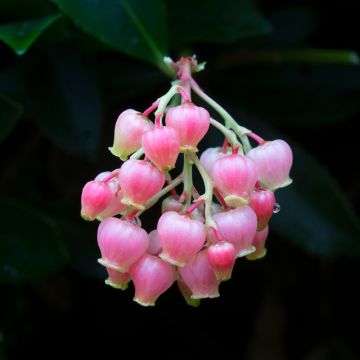

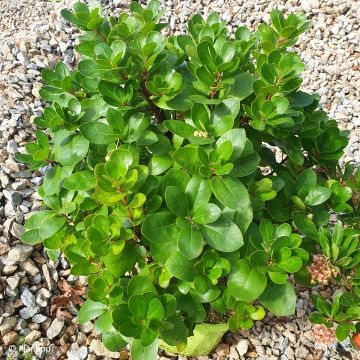
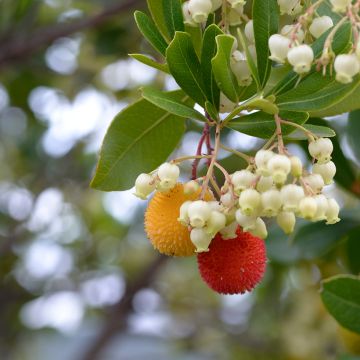



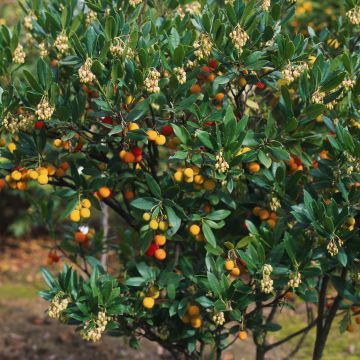
Comments